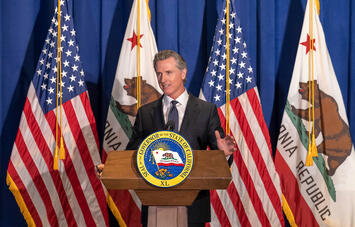
Many conservatives may see Gavin Newsom as the epitome of the progressive Left, with some even calling his policies “communist.” But the policy preferences of the California governor (whose presidential ambitions are evident) represent something more plausible and thus more dangerous: a blending of Peronist income redistribution coupled with the fanatically “green” authoritarian agenda embraced by the state’s dominant tech oligarchy, public-employee unions, and climate activists.
California politics often do not follow the patterns seen in other places. Its governmental model has failed, having recently been rated by WalletHub as the least efficient in delivering services relative to the tax burden it imposes on residents, and yet it continues to win voters’ support. The Golden State, after all, still works for many who bought their homes decades ago and have seen their values soar. It remains the terroir of choice for billionaires, movie stars, and venture capitalists, and it remains home to three of the world’s five leading tech companies. It has natural advantages such as a pleasant climate and often spectacular topography, which surpass anything Chicago, Detroit, or even New York could boast.
However, California’s and Newsom’s political future now relies on one thing: the ability and willingness of the state’s wealthy to continue to fund an incipient Peron-style welfare state. Roughly 100,000 taxpayers with incomes above $1 million — one-half of 1 percent of all tax returns filed in the state — collectively pay about 40 percent of all of California’s personal-income taxes, the state’s primary source of revenue. Without the ability to tap into the incomes of the richest of the rich, the whole system tilts towards failure.
Today the limits of the “California model” are being tested by realities such as a steadily declining population and a state deficit of $30 billion or more. Last year, a booming pandemic-driven tech economy, plus federal Covid transfers, generated a historic $100 billion surplus. Now, with the decline of start-ups, disasters such as Silicon Valley Bank’s failure, and falling real-estate prices, the revenue base has cratered. The decline in tech jobs — the San Francisco Chronicle estimates 100,000 so far — is shrinking California’s high-earning-taxpayer base, while the states that Newsom lambasts, such as Florida and Texas, enjoy large budget surpluses, generate more jobs, and, in some cases, initiate tax cuts.
During previous declines in the tech sector, California could look to other industries to sustain its economy. This is not so much the case now. Much of the blame for this lies with the state’s climate-obsessed regulatory regime. Once a major energy producer, California, desperate to get rid of both fossil fuels and nuclear power, now has the costliest electricity in the country. Companies that need power, including tech firms, are finding it increasingly challenging to stay in the state. One-third of manufacturing jobs — 1.3 million positions — have disappeared since 1990, well above the national average.
A state that once built the future now sees many of the rewards of innovation go elsewhere. Intel’s recent move to build its next-generation-chip fabs in Ohio represents a powerful symbolic loss for California. Except the original Tesla plant, even the battery and electric-vehicle industry, much of it nurtured by California regulation, is largely locating elsewhere. The electric-car future that Newsom craves likely won’t be built in “progressive” California but in Tennessee, Texas, Georgia, Kentucky, and Michigan. EV-battery plants in these states may owe their existence, in part, to subsidies, but California is more than willing to subsidize many things, such as movie-studio expansions that curry favor with Newsom’s political base. Even without adjusting for costs, notes the New York Times, no California city ranks in the U.S. top ten in terms of well-paying blue-collar jobs, but four — Ventura, Los Angeles, San Jose, and San Diego — sit among the bottom ten.
Read the rest of this piece at National Review.
Joel Kotkin is the author of The Coming of Neo-Feudalism: A Warning to the Global Middle Class. He is the Roger Hobbs Presidential Fellow in Urban Futures at Chapman University and Executive Director for Urban Reform Institute. Learn more at joelkotkin.com and follow him on Twitter @joelkotkin.
Photo: Office of the Governor of California, via Flickr under CC 2.0 License.













third base birth
Peron would have envied Gavin's personal wealth legacy.